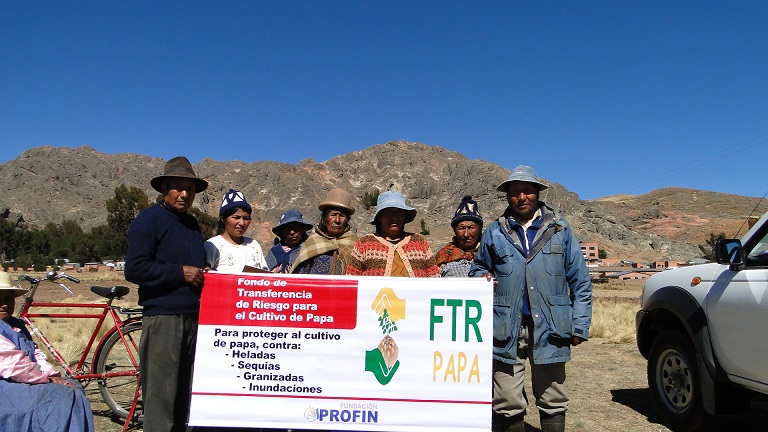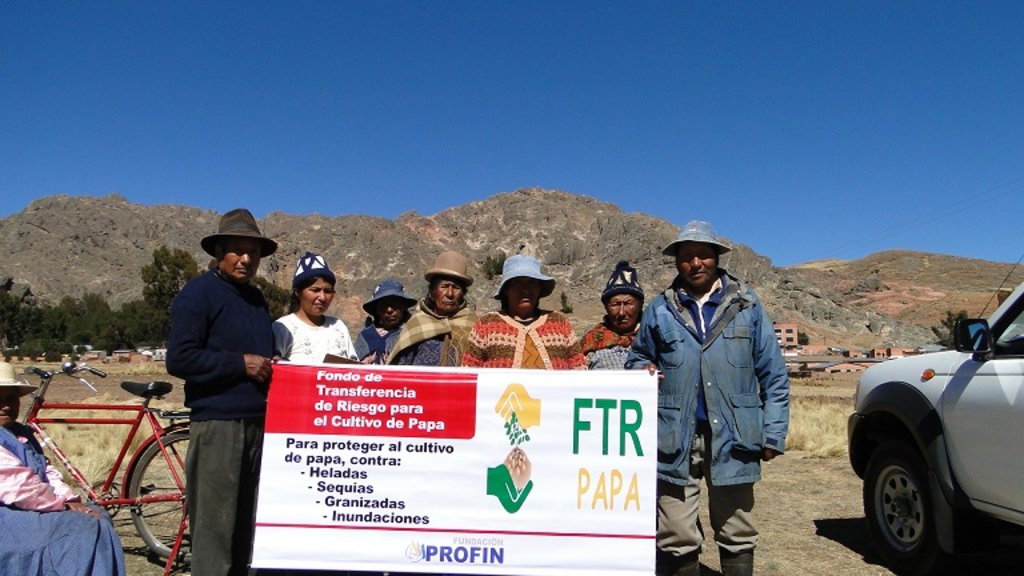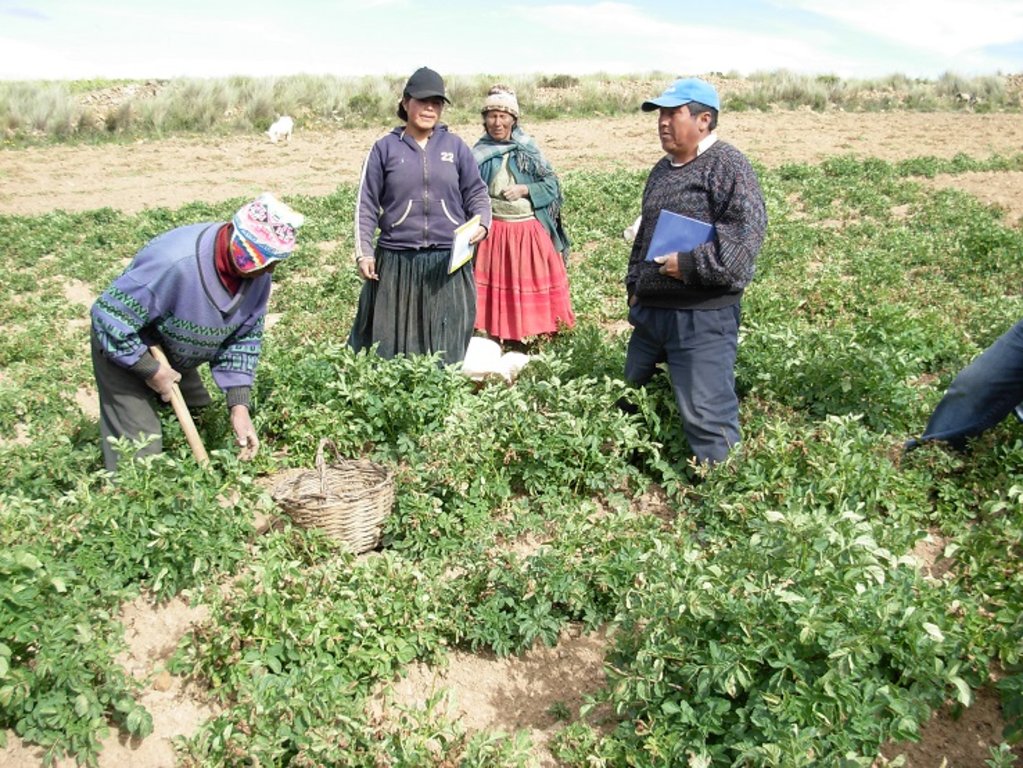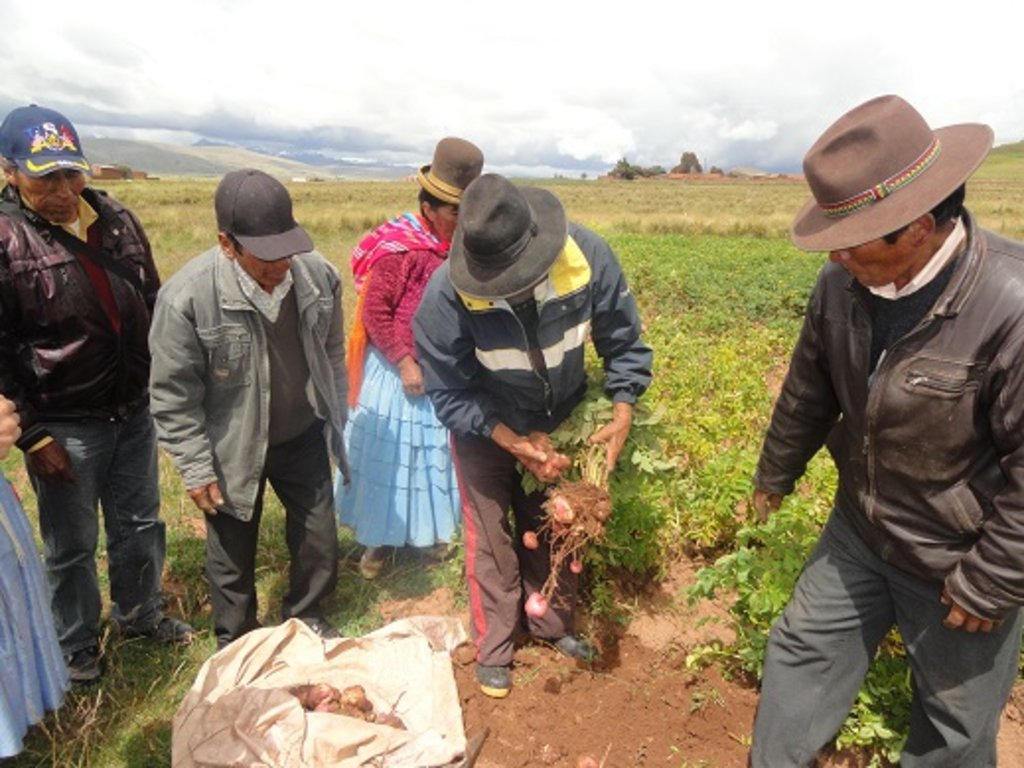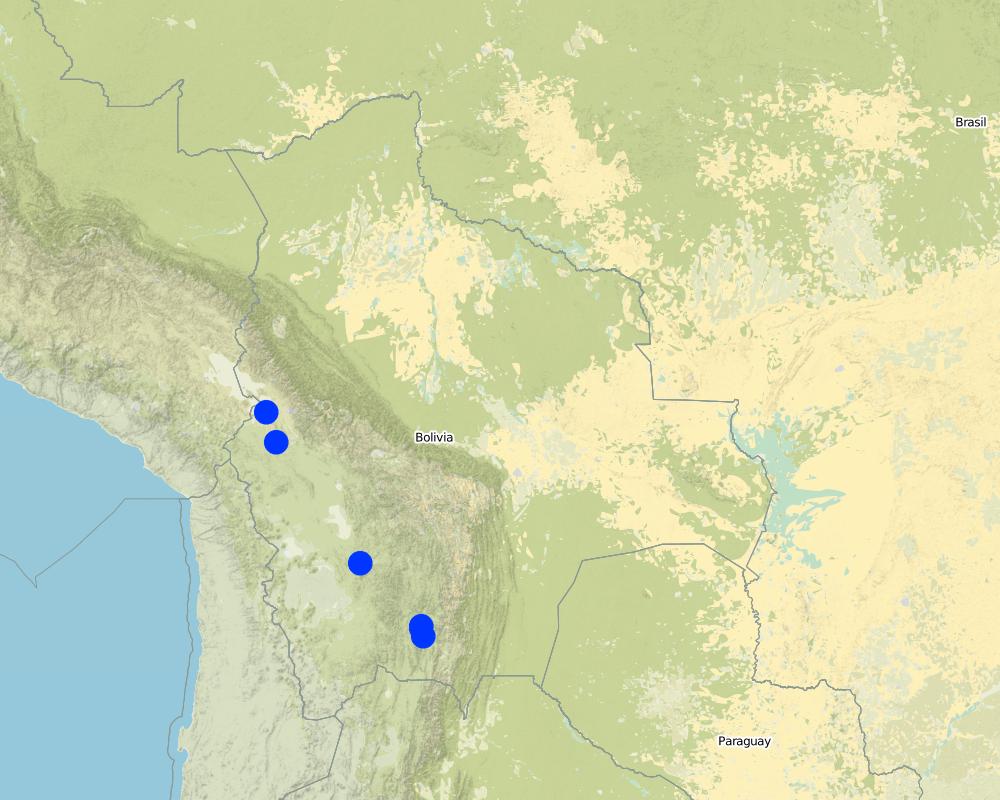Comprehensive Agrarian Risk Management (GRAI, acronym in Spanish for Gestión del Riesgo Agrícola Integral) [Bolivia, Plurinational State of]
- Creation:
- Update:
- Compiler: Marco Loma
- Editors: Javier Quispe, Eveline Studer
- Reviewers: Johanna Jacobi, Alexandra Gavilano
Gestión del Riesgo Agrícola Integral (GRAI)
approaches_693 - Bolivia, Plurinational State of
View sections
Expand all Collapse all1. General information
1.2 Contact details of resource persons and institutions involved in the assessment and documentation of the Approach
Key resource person(s)
PROSUCO (NGO project designer):
Quispe Maria
+591-2-412097
info@prosuco.org / prosuco.org@gmail.com
Asociación Promoción de la Sustentabilidad y Conocimientos Compartidos – PROSUCO (Association to Promote Sustainability and Shared Knowledges)
Av. Ecuador Nº 2253, between Rosendo Gutiérrez and Fernando Guachalla, Sopocachi, La Paz
Bolivia, Plurinational State of
PROFIN (NGO program designer) :
Vargas Edwin
+5912430850 / +5912430853
fundacionprofin@fundacion-profin.org
Fundación PROFIN
Av. Sánchez Lima, Edifico Tango, Mezzanine • Sopocachi • # 2600, La Paz
Bolivia, Plurinational State of
Helvetas (ONG, gestion de proyecto):
Name of project which facilitated the documentation/ evaluation of the Approach (if relevant)
Book project: where people and their land are safer - A Compendium of Good Practices in Disaster Risk Reduction (DRR) (where people and their land are safer)Name of the institution(s) which facilitated the documentation/ evaluation of the Approach (if relevant)
HELVETAS (Swiss Intercooperation)1.3 Conditions regarding the use of data documented through WOCAT
When were the data compiled (in the field)?
01/03/2014
The compiler and key resource person(s) accept the conditions regarding the use of data documented through WOCAT:
Yes
2. Description of the SLM Approach
2.1 Short description of the Approach
The purpose of the approach is to address disaster risks and climate extremes with Comprehensive Agrarian Risk Managment (GRAI, acronym in Spanish, for Gestión del Riesgo Agrícola Integral), tailored to the needs of small rural producers and including measures for prevention, mitigation, preparation and risk transference to create resilience to natural disasters.
(i) Good practices for agrarian producers were promoted, and
(ii) Risk transference financial mechanisms were identified through a form of insurance was tailored to the needs of rural producers.
2.2 Detailed description of the Approach
Detailed description of the Approach:
1. What are the main characteristics/ distinctive features of the approach?
The implementation of Comprehensive Agrarian Risk Management (GRAI for its acronym in Spanish) is based on two pillars:
(i) Agroclimate Risk Management (GRAC, acronym in Spanish for Gestión del Riesgo Agroclimático): to implement productive strategies according to the local context in order to reduce the risk of crop losses
(ii) Agrarian Financial Risk Management (GRAF, acronym in Spanish for Gestión del Riesgo Agrícola Financiera): to develop products and mechanisms of risk transference to compensate producers for economic loss, based on prevention, preparation and response measures.
2. What are the purposes/ objectives of the Approach?
To promote a combination of different sustainable measures and mechanisms for agrarian producers, improving the capacity of local actors (communities and municipalities) to enhance their capacity to respond to, prevent and mitigate risk.
3. What methods were used?
(i) Field practice, transfer of local capacities (GRAC) :
Support was provided to implement and disseminate goode agroecological practices with ecological products and measures that are simple and easily replicated, and which are tailored to the needs and capacities of producers and also revalue ancestral knowledge.
(ii) Financial risk transfer mechanisms (GRAF):
Pilot financial insurance mechanisms were designed and implemented for the most important crops in the area (potatoes, quinoa, grapes, peach). Producers accessed the fund by paying a prime. This provided indemnization in case they were affected or overwhelmed by a disaster. In other words, in case of a climate extreme (hail, frost, drought or excess rain), the damage to affected crops is assessed by an expert; this assessment is performned using a predefined and known methodology by a trained local expert (“Yapuchiri”) during field visits.
4. What were the stages of implementation?
The experience was carried out between February 2011 to March 2014. It began implementing pilot models and measures.
5. Which stakeholders were involved and what were their roles?
- Supramunicipal partners (associations of municipalities: Aymaras Sin Fronteras, Azanaque, Cintis, Andean Region of Cochabamba
- Jacha Suyu Pakajaqi Native Indigenous Peasant Organization and y Federations of Associations of Producer Unions of the Bolivian Altiplano.
- Partners at the national level: Ministry of Rural Development and Land (Ministerio de Desarrollo Rural y Tierras, MDRyT); -VDRA-; Agropecuarian and Climate Change Risk Management Unit (Unidad de Gestión del Riesgo Agropecuario y Cambio Climático, UGRACC) which works in the context of GRAC) and Ministry of Rural Development and Land INSA (in the context of GRAF).
6. What do the land users like or dislike about the approach?
the learning process and agricultural risk transference mechanisms tailored to the conditions and needs of small rural producers.
The combination of different mechanisms and measures to reduce and manage risk; this allows the producers to choose the most relevant measures to address their needs.
2.3 Photos of the Approach
2.5 Country/ region/ locations where the Approach has been applied
Country:
Bolivia, Plurinational State of
Region/ State/ Province:
In the valley and highland areas of the Department of Chuquisaca, La Paz, Potosi, Oruro and Cochabamba
Map
×2.6 Dates of initiation and termination of the Approach
Indicate year of initiation:
2011
If precise year is not known, indicate approximate date when the Approach was initiated:
more than 50 years ago (traditional)
Year of termination (if Approach is no longer applied):
2014
Comments:
Currently, the approach is still applied in the communities and the Bolivian government through the Agrarian Insurance Institute (INSA, acronym in Spanish for (Instituto del Seguro Agrario). INSA is in charge of replicating the approach and of scaling it up.
2.7 Type of Approach
- recent local initiative/ innovative
2.8 Main aims/ objectives of the Approach
Implement sustainable agrarian risk transfer mechanisms for agricultural producers, based on their needs for protection against climate risks and to enhance their resilience to natural disasters
2.9 Conditions enabling or hindering implementation of the Technology/ Technologies applied under the Approach
social/ cultural/ religious norms and values
- enabling
The socioproductive conditions of communities are based on cultural values such as reciprocity and complementarity; these allow implementing and transferring local practices through sharing experience, knowledge and indigenous knowledge.
availability/ access to financial resources and services
- enabling
The state encourages financial institutions to develop mechanisms allowing small agricultural producers in rural areas to access loans in better terms.
institutional setting
- enabling
The Agrarian Insurance Institute (INSA, acronym in Spanish for Instituto del Seguro Agrario) is a well established and important partner institution that is crucial to implement financial risk transfer mechanisms (GRAF). It allows producers to access indemnization without paying primes. This is made possible through government subsidies granted by the Bolivian State. The government (INSA) also promotes the development of non-financial mechanisms by implementing good practices, such as the use of certified seeds.
collaboration/ coordination of actors
- enabling
A producer organization, FUNAPA (acronym in Spanish for Federación de Unión de Asociación de Productores del Altiplano, Federation of the Union of the Association of Producers from the Altiplano), has implemented many experiences based on indigenous knowledge and practices, such as centers for organic bioinputs and agroclimate monitoring centers together with the participation of municipalities.
legal framework (land tenure, land and water use rights)
- enabling
Law 393 for Financial Services, issued in 2013, creates conditions for financial institutions to develop mechanisms that will allow small rural area producers access to loans under better terms.
Producers have property titles and their lands are registered as legal property.
Local institutions in charge for managing and using water as a public good for producers were established.
policies
- enabling
Law No. 144 for Productive, Community and Agropecuarian Revolution was issued. It creates the Agrarian Insurance Institute (INSA) and promotes the development of strategies at the national and subnational level that include risk management for agrarian production and organic production and respect and care for Mother Earth.
land governance (decision-making, implementation and enforcement)
- enabling
With the support of Law 144, producers can assume a leading role. In other words, they can make certain decisions and actions at the local level when consensus is reached at the local level with other producers and local authorities.
knowledge about SLM, access to technical support
- enabling
Sustainable agroproductive practices are revalued. This is seen in the recovery and documentation of ancestral knowledge to predict weather based on bioindicators; these indicators are recorded in a log book known as "Pachagrama". Another practice involves using organic biofertilizers manufactured by the producers, as well as damage and accident assessment of crops, also performed by the producers themselves.
markets (to purchase inputs, sell products) and prices
- enabling
Market opportunities are created for producers. For example, certified potatoes and seeds are sold to government, non-government institutions. Quinoa producers were able to access fair trade, and obtained the FLO stamp.
workload, availability of manpower
- enabling
Family labor was provided to build small infrastructure, such as the bioinput centers. The participation of families has been acnowledged as project counterpart contribution from the stakeholders.
3. Participation and roles of stakeholders involved
3.1 Stakeholders involved in the Approach and their roles
- local land users/ local communities
Farmers, i.e. small agrarian producers who represent the main economic activity of the area. They produce subsistence crops.
Stakeholders implement agrarian practices and measures.
They help the documentation efforts and to revalue local knowledge.
They learn the importance of having agrarian insurance.
- community-based organizations
Local authorities.
Native Indigenous Peasant Organization Jacha Suyu Pakajaqi (Organización Indígena Originario Campesino Jacha Suyu Pakajaqi) and the Federation of the Union of Producer Associations of the Altiplano.
Support agricultural initiatives involving good farming practices and the risk transference fund.
- SLM specialists/ agricultural advisers
Leading farmers („Yapuchiri“)
Potato, quinoa, grape and peach crops are the most important in the area. Pilot Financial Insurance mechanisms were designed and implemented for these crops and included in the Agrarian Risk Transfer Fund.
Producers accessed the fund by first paying a prime that provided them with insurance in case of climate extremes such as hail, frost, drought or excessive rains. In case of a weather extreme, an expert assesses the damage to affected crops, following a predefined and approved method. The expert is a trained local leader known as “Yapuchiri”, and he performs the assessment through field visits.
The “Yapuchiri” also monitors the operation of the transfer fund at the local level, i.e. the compensation for damage the producers have suffered.
- teachers/ school children/ students
- NGO
HELVETAS Swiss Intercooperation (Swiss Cooperation Project to Reduce Disaster Risks )
PROSUCO Acronym in Spanish for Asociación Promoción de la Sustentabilidad y Conocimientos Compartidos (Association to Promote Sustainability and Shared Knowledge)
PROFIN - Fundación para el Desarrollo Productivo y Financiero (Foundation for Productive and Financial Development)
Project management, coordination and monitoring.
Support to discuss issues.
Develop capacities at the national and subnational level
Design and develop financial and non financial mechanisms for risk transference .
- local government
Municipal authorities from municipal governments
Promoting and implementing policies for risk transference mechanisms to be set in place.
Integrate risk management in the institution with processes carried out in municipalities, such as the development plans and local budget
- national government (planners, decision-makers)
INSA Instituto del Seguro Agrario (Agrarian Insurance Institute)
Viceministry of rural development and land
Legal and institutional frameyork to support agrarian producers by providing them with protection for their production and livelihoods in case of climate extremes.
Development and implementation of risk transference mechanisms .
Creation of favorable conditions that foster democracy, equity and inclusion, that respect native indigenous uses and customs.
- international organization
Swiss government through Swiss Cooperation in Bolivia (COSUDE)
Project funding
If several stakeholders were involved, indicate lead agency:
INSA Instituto del Seguro Agrario (Agrarian Insurance Institute)
3.2 Involvement of local land users/ local communities in the different phases of the Approach
| Involvement of local land users/ local communities | Specify who was involved and describe activities | |
|---|---|---|
| initiation/ motivation | self-mobilization | Agrarian producers are aware, are motivated and possess knowledge required to revalue local and ancestral knowledge to manage agricultural risk. |
| planning | interactive | Agricultural producers interact with their matrix organization and municipal government for planning. they are supported by PROSUCO, PROFIN and HELVETAS. |
| implementation | interactive | Agricultural producers contribute family labor to build small facilities, such as bioinput centers. |
| monitoring/ evaluation | interactive | PROSUCO and PROFIN, as implementation partners, have set in place a monitoring system, with close cooperation with partner institutions and beneficiaries (parmers) to measure and document the effects. |
| Capitalizing from the experience | interactive | Exchange is an important aspect of the project, as well as capitalizing from and documenting the experience. This was all performed through field visits, events, fairs and publishing reading material with the help of diverse actors (INSA, associations, PROSUCO, PROFIN etc.) |
3.4 Decision-making on the selection of SLM Technology/ Technologies
Specify who decided on the selection of the Technology/ Technologies to be implemented:
- mainly land users, supported by SLM specialists
Explain:
Agricultural producers were supported throughout the process by other leading organizations, such as "Kamayoc" from Peru, field schools from Nicaragua and project specialists, i.e. NGOs, and PROSUCO for technological innovation, and PROFIN for microfinancial services.
Specify on what basis decisions were made:
- evaluation of well-documented SLM knowledge (evidence-based decision-making)
4. Technical support, capacity building, and knowledge management
4.1 Capacity building/ training
Was training provided to land users/ other stakeholders?
Yes
Specify who was trained:
- land users
- field staff/ advisers
If relevant, specify gender, age, status, ethnicity, etc.
Producers, women and children are more vulnerable to climate extremes. They participated in training events to identify alternatives and measures that could be taken.
Form of training:
- farmer-to-farmer
- demonstration areas
- public meetings
- courses
Subjects covered:
i) Sustainable practices were taught in the non-financial component (GRAC). These practices included the manufacturing of bioinputs with ecological fertilizers, mineral soups, natural insect repellents.
ii) In the financial domain (GRAF), trainings for financial risk transfere mechanisms were provided; also, participants were briefed on the operation and advantages of the Risk Transference Fund.
Comments:
Actions should place strong emphasis on sustainability and ensuring the measures are easy to replicate because of the low cost involved in implementing them. The measures should be taught by doing. Further, local leadership should be promoted and be involve the participation of different government levels (community, municipal and national government).
4.2 Advisory service
Do land users have access to an advisory service?
Yes
Specify whether advisory service is provided:
- on land users' fields
Describe/ comments:
In general terms, the support and assessment of good practices are passed on from producer to producer. The Yapuchiri, a producer in a leadership position, must have an important role and should exchange information with their counterparts from Peru ("Kamayoc").
PROSUCO provided farmers with support for technoloogical innovation and from PROFIN to learn about financial services.
4.3 Institution strengthening (organizational development)
Have institutions been established or strengthened through the Approach?
- yes, greatly
Specify the level(s) at which institutions have been strengthened or established:
- local
Describe institution, roles and responsibilities, members, etc.
Federation of Producer Association Unions from the Altiplano (Federación de Unión de Asociaciones Productivas del Altiplano). This institution brings together potato growers from the Altiplano region and helps its member organizations to strengthen their capacities
.
The Native Indigenous Peasant Organization Jacha Suyu Pakajaqi brings together communities and promotes development in these.
Producer organizations from the CINTIS region.
Specify type of support:
- financial
- capacity building/ training
Give further details:
Capacities were developed through parthers such as PROSUCO (Acronym in Spanish for Association to Promote Sustaimnability and Shared Knowledge, Asociación Promoción de la Sustentabilidad y Conocimientos Compartidos).
Financial mechanisms were designed and adjusted in the frame of the Risk Transference Funds.
4.4 Monitoring and evaluation
Is monitoring and evaluation part of the Approach?
Yes
Comments:
Financial insurance mechanisms were designed for the most common crops (potatoes, quinoa, grapes, peaches) in the frame of the Agrarian Risk Transference Funds.
When a weather extreme takes place (hail, frost or drought), a technical assessment is performed on the affected croplands. The assessment uses a predefined and familiar methodology, and is carried out by a local leader, a producer who has been properly trained to do so, the “Yapuchiri”. He performs the assessment through field visits.
Furthermore, the “Yapuchiri” monitors the operation of the transfer fund at the local level, i.e. the compensation provided according to the damage suffered. INSA (Agrarian Insurance Institute) monitors all reported events and insurance claims at the national level. All these mechanisms together ensure monitoring of the financial mechanisms at the local and national level. This aspect is in the domain of GRAF.
If yes, is this documentation intended to be used for monitoring and evaluation?
Yes
Comments:
The methodology used for assessing damage according to crop and extent of the damage can be used for monitoring.
4.5 Research
Was research part of the Approach?
No
5. Financing and external material support
5.1 Annual budget for the SLM component of the Approach
If precise annual budget is not known, indicate range:
- 100,000-1,000,000
Comments (e.g. main sources of funding/ major donors):
Value refers to the entire project to reduce climate extreme risks.
5.2 Financial/ material support provided to land users
Did land users receive financial/ material support for implementing the Technology/ Technologies?
Yes
If yes, specify type(s) of support, conditions, and provider(s):
Producers received basic input to execute good practices (containers and agrofilm to make biofertilizers, etc)
5.3 Subsidies for specific inputs (including labour)
- agricultural
| Specify which inputs were subsidised | To which extent | Specify subsidies |
|---|---|---|
| partly financed | Basic input to produce mineral mixtures, biofertilizers | |
- construction
| Specify which inputs were subsidised | To which extent | Specify subsidies |
|---|---|---|
| Foundations for the Bioinput Centers | ||
| Beams for the roofs of Bioinput Centers | ||
| biocentros | partly financed | Inputs not locally available to build bioinput centers: - Foundations - Beams for the roof - Doors and windows |
If labour by land users was a substantial input, was it:
- voluntary
Comments:
All of the producers manufactured biofertilizers, as per the trainings provided by the Bioinput Centers.
5.4 Credit
Was credit provided under the Approach for SLM activities?
No
5.5 Other incentives or instruments
Were other incentives or instruments used to promote implementation of SLM Technologies?
Yes
If yes, specify:
An Agrarian Risk Transference Fund (an agricultural microinsurance) was set up as a financial mechanism aimed at producers of potatoes, grapes and peaches with resources from the Project to Reduce Climate Extremes Risks from Swiss Cooperation, implemented by Helvetas Swiss Intercooperation, with the support of PROFIN, .
Producers accessed the fund through a prime payment that allowed them to receive indemnization in case they were affected by a climate extreme (hail, drought, frost or excessive rain).
6. Impact analysis and concluding statements
6.1 Impacts of the Approach
Did the Approach empower local land users, improve stakeholder participation?
- No
- Yes, little
- Yes, moderately
- Yes, greatly
We observed local knowledge was widely revalued. For example bioindicators were being used for local weather forecasting. We also saw good practices were put in effect (people used biofertilizers). Producers know and are aware of the relevance of the Risk Transference Fund.
Did the Approach enable evidence-based decision-making?
- No
- Yes, little
- Yes, moderately
- Yes, greatly
The learning by doing methodology was promoted based on the evidence provided, which took the form of the experiences shared by local promoters, the "Yapuchiris", farmers ofrom FUNAPA (acronym in Spanish for Federación de Unión de Productores del Altiplano de La Paz, Federation of Producer Unions from the Altiplano of La Paz). i) Non-financial interventions (GRAC) One of the most important practices is the local agroclimate weather forecast based on bioindicators monitored and documented in a logbook known as "Pachagrama". Another example is the creation and operation of bioinput centers used to provide biofertilizers to producers from the involved communities. ii) Financial interventions (GRAF): damage assessment to grape, peach, potato and quinoa crops performed by trained farmers/ local experts. All the products and mechanisms involved in the approach were developed with the participation and concertation of farmers and experts. Thus, these methods and results are considered relevant for decision-making.
Reducción de pérdidas en la producción anual de sus cultivos, para el ejmplo de papa aproximdamente de mas de un 50 %, según las percepciones de los propios productores. Los rendimientos en el cultivo de papa se incrementaron entre el 67% y el 144% en relación al rendimiento promedio nacional y rendimientos promedio locales de agricultores sin proyecto. Para el caso de productores de uva y durazno este mecanismo les permitió reducir perdidas hasta un 25 a 30 % (fuente, SERIE Consolidación de la Gestión del Riesgo Agrícola Integral - GRAI, 2014)
Did the Approach improve coordination and cost-effective implementation of SLM?
- No
- Yes, little
- Yes, moderately
- Yes, greatly
The results of good agrarian practices show a good cost-benefit ration: producers indicated that losses in the annual potato crops were reduced in over 50%. Potato crop yields increased between 67% to 144% compared to the average national yield and local yield averages of potato growers not covered in the project. Grape and peach farmers were able to reduce losses by 25 to 30 % (Source: SERIES Consolidación, GRAI, 2014)
Con la medidad non financieros (GRAC) se puse reducir las perdidas en los cultivos frente eventos climaticos. Eso sirvio para que los agricultores paguen sus primas y se beneficien del fondo de transferencia del riesgo.
Did the Approach improve knowledge and capacities of land users to implement SLM?
- No
- Yes, little
- Yes, moderately
- Yes, greatly
Farmers learned about the importance of comprehensive management of disaster risk reduction by using preventiion, mitigation and risk transference measures.
Did the Approach improve knowledge and capacities of other stakeholders?
- No
- Yes, little
- Yes, moderately
- Yes, greatly
i) The experience in the financial domain (GRAF) allowed government partners (INSA) to set the bases of the financial component to implement the agricultural insurance. Afterwards, the insurance expanded its coverage to include more crops: potato, quinoa, wheat, fava beans, barley, alfalfa, corn and lentils (Source: Ministry of Rural Development and Land and INSA, 2016). ii) The non-financial component (GRAC) promoted the implementation of comprehensive and complementary agricultural risk management strategies for prevention, mitigation and primary productive response. These measures are managed and implemented by local actors and municipal, departmental and national institutions, using agroclimate maps, Community Bioinput centers and agroclimate forecasts ("Pachagram")
Los modelos de transferencia desarrollados inspiran a la realización de otros, donde el conocimiento local y las buenas prácticas son elementos clave.
Did the Approach empower socially and economically disadvantaged groups?
- No
- Yes, little
- Yes, moderately
- Yes, greatly
The financial component (GRAF) provided access to insurance to people who had none before. Implementing good practices has benefitted producers who lacked technology to improve their performance and access to market.
Se fomento un enfoque inclusivo respecto a genero y generaciones , considerando que la población con la que se trabajo fueron pequeños agricultores, cuya mano de obra es familiar. Las capacitaciones, talleres, intercambios de experiencia fueron basadas en el conocimiento local, fomentaron el saber ancestral y fueron generalmente realizadas en las parcelas y áreas de trabajo de los mismos productores, la base del enfoque "aprender - haciendo".
Did the Approach encourage young people/ the next generation of land users to engage in SLM?
- No
- Yes, little
- Yes, moderately
- Yes, greatly
Knowledge management (training, workshops, sharing experiences) on the field (farm plots) enabled women, young people and children to participate in the activities involved in the approach. Knowledge management is in the hands of experts with diverse expertise. Further, this is an example for the communities' younger generations, who will grow up knowing they can feasibly grow and become good producers thanks to the diverse strategies they can use to manage risks and adapt to climate change.
Did the Approach lead to improved food security/ improved nutrition?
- No
- Yes, little
- Yes, moderately
- Yes, greatly
In areas where the project was implemented, the yield of potato crops improved in over 100 % and 25% in fruit crops such as grape and peach. This is very important, since most of the farmers are small subsistence growers.
Hubieron productores principalmente de papa y quinua, cuyos rendimientos y la calidad de los mismos (productos orgánicos) incrementaron y redujeron sus pérdidas, logrando mantener un equilibrio productivo anual y así llegar a un mercado mas diversificado, como las ciudades y supermercados.
Principalmente a la valoración de superficie de tierra, ya que con las practicas de recuperación de suelos a través del uso de abonos tipo bocashi, incorporación de estiercol de animales, mejoraron las condiciones de sus tierras, aun en pequeñas superficies. Respecto al saneamiento, la implementacion de los mapas de riesgos comunales, permitieron una mejor percepcion de su tierras y mejor distribución de las mismas en sus diferentes usos comunales. Ejemplo comunidad de Yanarico del municipio de Tihuanacu del departamento de La Paz.
Did the Approach lead to more sustainable use/ sources of energy?
- No
- Yes, little
- Yes, moderately
- Yes, greatly
Biodigesters were built; these can be used to manufacture liquid fertilizers such as biol and also to cook food. All the biofertilizers that are manufactured and promoted allow recycling and reusing locally available materials that are usually discarded (hay stubble, grass, guano) to manufacture biological fertilizer. This provides an alternative to chemical fertilizers, the latter of which involve a high degree of energy consumption for production.
Did the Approach improve the capacity of the land users to adapt to climate changes/ extremes and mitigate climate related disasters?
- No
- Yes, little
- Yes, moderately
- Yes, greatly
The purpose of the measures involved allow small farmers to address climate change. Producers developed capacities in deploying agroecological measurers for risk prevention and mitigation and adaptation to climate change. This approach also includes with measures to manage risk when planning agricultural production, such as local weather forecasting using bioindicators and local strategies aimed at risk prevention and mitigation and the use of biofertilizers and response measures. By recovering ancestral knowledge used for forecasting and monitoring the weather, the stakeholders can calculate rainy seasons and the intensity of hail or frost.
6.2 Main motivation of land users to implement SLM
- increased profit(ability), improved cost-benefit-ratio
Due to loss reduction.
- reduced risk of disasters
Substancial reduction of productive loss due to frost, hailstorms and other climate phenomena/ natural disasters.
- enhanced SLM knowledge and skills
6.3 Sustainability of Approach activities
Can the land users sustain what has been implemented through the Approach (without external support)?
- yes
If yes, describe how:
Good agricultural practices are replicated using a model involving knowledge transfer from producer to producer.
The practices involved have a strong sustainability approach; they are easy to execute and have low implementation costs, thus they are easily replicated. They are taught by doing and promote local leadership. Also, they promote articulation and cooperation at different government levels (community, municipality, governorship and ministries).
It is evident that financial mechanisms require more support from specialized financial institutions with significant presence in rural areas.
6.4 Strengths/ advantages of the Approach
| Strengths/ advantages/ opportunities in the land user’s view |
|---|
| The combination of different mechanisms and measures to reduce and manage risk allow the producer to choose from a variety of measures to find those most relevant to address his needs. |
| Promoting and disseminating good agroecological practices that can be used for risk prevention, mitigation and adaptation, by including these in the process of agricultural production. |
| Strengths/ advantages/ opportunities in the compiler’s or other key resource person’s view |
|---|
| The approach combines financial and non-financial mechanisms to reduce and manage risk by collaborating with diverse institutions and actors, allows establishing financial and non-financial mechanisms to replicate and develop further examples that can be valuable for INSA (Agricultural Insurance Institute). |
| Generate financial and non-financial mechanisms to transfer risk; this is an important reference for INSA (Agricultural Insurance Institute) to replicate other inspiring ideas that can be replicated and further developed. |
6.5 Weaknesses/ disadvantages of the Approach and ways of overcoming them
| Weaknesses/ disadvantages/ risks in the land user’s view | How can they be overcome? |
|---|---|
| Financial mechanisms need specialized institutions present in rural areas. | Municipal governments must generate conditions and create alliances with financial entities to promote financial mechanisms that can be used to transfer risk. |
7. References and links
7.1 Methods/ sources of information
- field visits, field surveys
Information resulting from follow-up on producers while implementing the practices. 2180 producers applied the practices according to their specific needs, productive context and livelihoods. 498 families were insured with risk transference funds.
- compilation from reports and other existing documentation
Reports from PROSUCO and PROFIN were used; also, experiences derived from the previous phase of the risk reduction program (PRRD) were capitalized.
7.2 References to available publications
Title, author, year, ISBN:
Consolidación de la Gestión del Riesgo Agrícola Integral (GRAI), PROSUCO-PROFIN-Helvetas-COSUDE, 2014
Available from where? Costs?
http://www.rrd.com.bo/wp-content/uploads/2015/publi_fases/fase_03/19PROS.pdf
7.3 Links to relevant information which is available online
Title/ description:
programa de reducción del riesgo de desastres (PRRD), Helvetas, COSUDE Bolivia, colecion de todas las publicaciones del proyecto
URL:
http://www.rrd.com.bo
Title/ description:
PachaGrama agroclimate logbook, MDRyT and PRRD partners, 2012
URL:
http://www.rrd.com.bo/wp-content/uploads/2015/publi_fases/fase_03/07pachagrama2br.pdf
Links and modules
Expand all Collapse allLinks
No links
Modules
No modules


